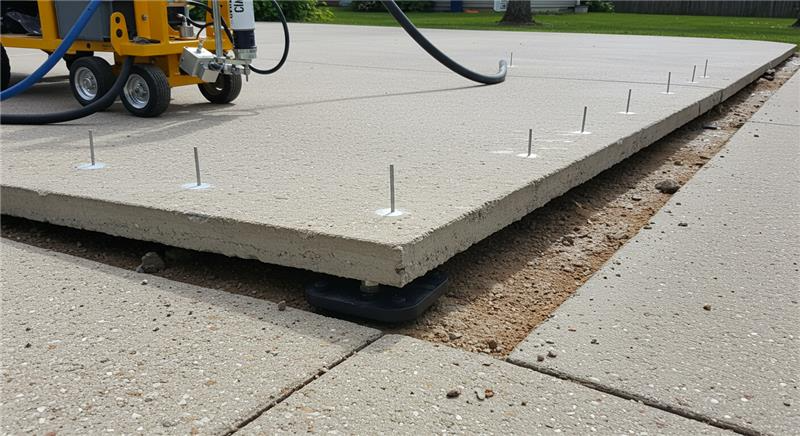
Most homeowners don’t expect to see their driveway or patio tilting like a sinking ship. But when it happens, they’re left wondering: does slab lifting actually work, or is it just a temporary patch?
We get these questions all the time at On the Mark Spray Foam Insulation. And the truth is—done right, concrete slab lifting works remarkably well. Not just in theory, but in real driveways and patios across our Florida communities. The key? The method, materials, and the team behind the job. This guide is our no-nonsense answer, built on years of hands-on experience with polyurethane foam lifting.
If you want straight answers, examples from the field, and expert advice from the crew who’s fixed everything from cracked patio corners to driveway sink holes you’re in the right place.
It usually starts with a dip. Then comes the cracking. You avoid pulling into one side of your driveway. Or your patio furniture keeps sliding downhill.
These issues stem from soil erosion, settling, or improper compaction when the concrete was first poured. Water intrusion is often the main culprit. Over time, the ground beneath your concrete gives way. The slab sinks. Cracks form. Your home’s exterior starts looking neglected.
At On the Mark Spray Foam Insulation, we use high-density polyurethane foam for slab lifting. It’s injected beneath the concrete through small holes, expands instantly, and solidifies within minutes. That expansion fills gaps, compacts loose soil, and gently lifts the slab back into position.
There’s no need to rip out the slab or wait for new concrete to cure. Most projects take just a few hours. And best of all, the results are long-lasting.
Tearing out and replacing concrete is time-consuming, expensive, and disruptive. Slab lifting solves the same problem without weeks of downtime or major mess. Our clients save thousands by choosing foam lifting over full replacement and they get results that last.
Not all surfaces are created equal. Slab lifting works best when the structure is mostly intact—meaning it’s cracked or tilted, not crumbling apart.
Driveways and patios typically meet that condition. They’re large, flat, and prone to settling. Foam lifting allows for precise, controlled elevation perfect for restoring level ground without creating new problems.
We’ve seen driveways drop several inches in areas where water drains poorly or soil wasn’t properly compacted. Foam lifting corrects those dips without compromising the integrity of surrounding slabs. In many cases, the result is a completely level surface with no visible signs of repair.
If your patio slopes toward your home, you could be facing serious drainage issues. That water ends up where it shouldn’t along your foundation. Lifting the patio slab can restore the proper slope and help prevent long-term damage to your home’s base.
We’ve built our process around convenience, precision, and lasting results. Here’s what it looks like when we’re called out for slab lifting.
We aren’t just showing up to lift slabs we’re solving a long-term issue. That means understanding drainage patterns, soil behavior, and how Florida’s climate affects foundational support. Our experience means fewer surprises, faster turnarounds, and durable results.
A lot of homeowners wonder if slab lifting is just a quick fix. Here’s what we’ve seen:
Lifting your slab is one part of the equation. Addressing poor drainage ensures the repair holds up over time. If we see water issues contributing to sinking concrete, we’ll help you identify solutions that protect your investment.
Because there’s no demolition involved, foam lifting is one of the least disruptive ways to restore concrete. Most homeowners are surprised by how quick the process is from estimate to completion.
If your driveway or patio is uneven, cracked, or sinking don’t wait for it to get worse. On the Mark Spray Foam Insulation is ready to help with expert slab lifting solutions that restore safety, function, and appearance.
Our team has years of hands-on experience using polyurethane foam to fix real problems for Florida homeowners, and we’ll treat your project with the care and precision it deserves.
Call us today at (813) 921-0444 or email info@onthemarksprayfoam.net to schedule your assessment. We’re here to lift your concrete and your peace of mind.
Yes, as long as the slab is structurally sound. We’ve lifted driveways over 20 years old with great success.
Most projects are completed in a few hours. You can use the surface again the same day.
Polyurethane foam lifting is more precise, lasts longer, and adds less weight to the soil below.
No. It’s water-resistant and doesn’t shrink or break down under normal conditions.
Absolutely. We can lift specific slabs to match the rest, without disturbing surrounding concrete.
We carefully monitor every lift in real-time. If more lift is needed, we adjust immediately.
It varies by project size and severity, but it’s usually much cheaper than replacement.
We seal the injection points with matching concrete. They’re barely noticeable.
Yes, lifting can re-establish the correct slope and eliminate water collection points.
Not necessarily, but we do recommend being available during the initial walkthrough.